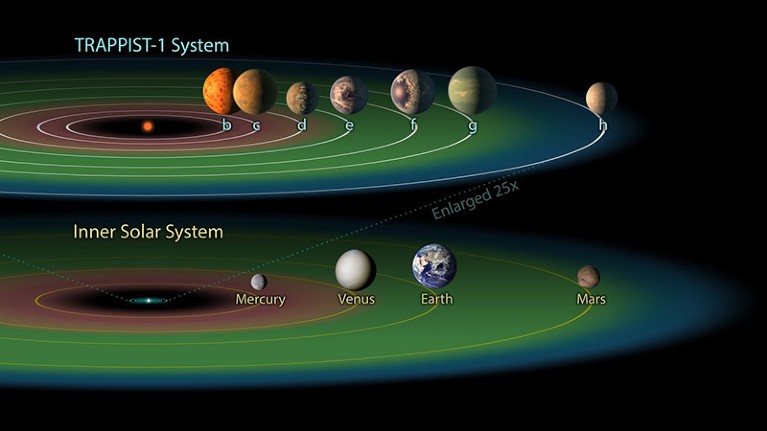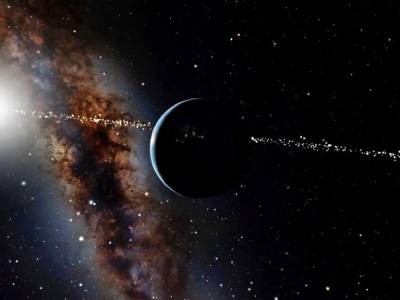The James Webb Space Telescope (JWST) has gotten its first look at a hotly anticipated set of targets — the atmospheres of some of the seven Earth-sized planets circling the star TRAPPIST-1, just 12 parsecs (39 light-years) from Earth. All seven lie in or near their star’s habitable zone, where liquid water could exist, and astronomers consider them the best known laboratory for studying what makes planets beyond the Solar System suitable for life.
These seven alien worlds could help explain how planets form
What researchers have seen so far is preliminary and doesn’t yet indicate what sorts of atmospheres these planets might actually have. But if they have dense atmospheres with intriguing molecules such as carbon dioxide or methane, the US$10-billion telescope will be able to detect them in the coming months and years. No other observatory has been powerful enough to spot these atmospheres.
“We’re in business,” Björn Benneke, an astronomer at the University of Montreal, said during a symposium on first results from JWST in Baltimore, Maryland, on 13 December.
Prized planets
The TRAPPIST-1 planetary system, mapped out in 2017, offers astronomers multiple chances at understanding the formation and evolution of Earth-sized worlds around a single star. The star is relatively faint and cool, and the seven planets are nestled closer to it than Mercury orbits the Sun.
JWST is observing all of the planets in its first year of science operations, which began in June. Many of those observations have already been taken, but none had been shown publicly until this week’s symposium, which took place at the Space Telescope Science Institute, the operations centre for JWST.

All of the planets in the TRAPPIST-1 system are closer to their star than Mercury is to the Sun.Credit: NASA/JPL-Caltech
The TRAPPIST-1 planets are designated b through h, with b being closest to the star and h farthest.
Benneke showed the first JWST studies of TRAPPIST-1g. So far, the telescope has been able to make out that it probably doesn’t have a hydrogen-rich atmosphere — which would be relatively easy to spot because it is so physically large. That could mean that the planet has a denser atmosphere, made of heavier molecules, such as carbon dioxide, or no atmosphere at all.
JWST studies planetary atmospheres primarily by watching how they filter starlight shining through them as they pass in front of the star. Which molecules make up a planet’s atmosphere can indicate how it evolved and whether it might have life on its surface. It will take more observations and time to analyse the data so far collected, before researchers will know if TRAPPIST-1g has an atmosphere, and if so what it is made of.
Constructing a ‘family portrait’
The TRAPPIST-1 data are much harder to analyse than those gathered from larger exoplanets, including WASP-39b, a planet closer to the size of Jupiter that JWST has studied in detail. TRAPPIST-1’s planets are much smaller, and the signal from their atmospheres more difficult to tease out. Magnetic disturbances in TRAPPIST-1 can also induce signals that confound interpretations of the data.
The 2,000 stars where aliens would catch a glimpse of Earth
“We needed this first look to know what we’re dealing with,” says Knicole Colón, an astronomer at NASA’s Goddard Space Flight Center in Greenbelt, Maryland, who was not involved in the work. Benneke declined to speak with reporters about the TRAPPIST-1g results, citing a paper under review at a scientific journal.
In a poster presentation at the conference, Olivia Lim of the University of Montreal showed two JWST observations of the innermost planet in the system, TRAPPIST-1b. She, too, has not been able to tease out a signal indicating the planet’s atmosphere just yet. But preliminary studies suggest that it, like planet 1g, probably doesn’t have a puffy, hydrogen-rich atmosphere.
Lim has several more observations of other TRAPPIST-1 planets already in-hand, including one taken last week that she hasn’t had time to look at yet in the crush of JWST results. “It’s hectic,” she says.
But more results on the extraordinary planetary system are on the way, Colón says: “Within the next year we’ll have a family portrait.”


